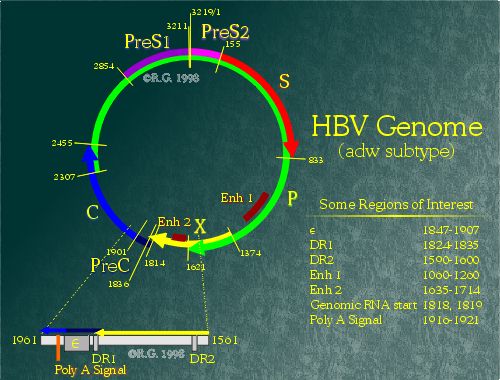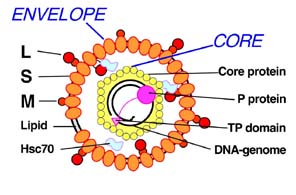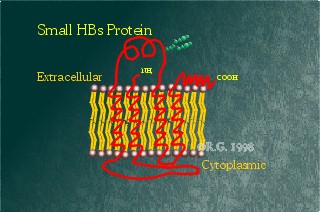Home
What is HBV?
The Hepatitis B Virus
The Hepatitis B virus (HBV) is a mostly double-stranded
DNA virus in the Hepadnaviridae family. One of five hepatitis viruses,
HBV causes acute and chronic hepatitis in humans. Despite the current availability
of an effective vaccine, almost 1.2 million people worldwide still die
each year from HBV related diseases (CDC). An acute
HBV infection usually causes only mild symptoms and the majority of infected
adults successfully clear the virus and acquire life-long immunity. In
acute hepatitis, it takes about 1 to 6 months from the time of infection
for the disease to manifest itself. Early symptoms include nausea and vomiting,
loss of appetite, fatigue, and muscle and joint aches. Jaundice, together
with dark urine and light stools, follows. Only about 1 percent of patients
infected with hepatitis B die due to liver damage in this early stage (Poynard,
2002).  The
risk of becoming chronically infected depends on the age at the time of
infection. More than 90 percent of newborns, 50 percent of children,
5 percent of adults infected with HBV develop chronic hepatitis. Those
who are unable to produce an effective immune response allow the virus
to replicate for long periods in their livers, causing chronic hepatitis
HBV infection, cirrhosis of the liver, and hepatocellular
carcinoma (HCC) (Yen, 2002). Transmission of
the hepatitis B virus is through contact with blood and other bodily fluid.
Chronic hepatitis B is treated with a manufactured form of interferon,
a protein made naturally by the body to boost the immune system and to
regulate other cell functions (CDC). A vaccine
is available to prevent HBV which originally consisted of purified HBV
surface antigens (HBsAg) prepared from the serum of carriers and wash chemically
treated to kill any contaminating viruses, but the current vaccine is genetically
engineered HBsAg produced in yeasts (Yen, 2002).
The
risk of becoming chronically infected depends on the age at the time of
infection. More than 90 percent of newborns, 50 percent of children,
5 percent of adults infected with HBV develop chronic hepatitis. Those
who are unable to produce an effective immune response allow the virus
to replicate for long periods in their livers, causing chronic hepatitis
HBV infection, cirrhosis of the liver, and hepatocellular
carcinoma (HCC) (Yen, 2002). Transmission of
the hepatitis B virus is through contact with blood and other bodily fluid.
Chronic hepatitis B is treated with a manufactured form of interferon,
a protein made naturally by the body to boost the immune system and to
regulate other cell functions (CDC). A vaccine
is available to prevent HBV which originally consisted of purified HBV
surface antigens (HBsAg) prepared from the serum of carriers and wash chemically
treated to kill any contaminating viruses, but the current vaccine is genetically
engineered HBsAg produced in yeasts (Yen, 2002).
Liver
Cancer
Molecular Virology
 Genome:
The
HBV virion genome is circular and approximately 3.2 kb in size and consists
of DNA that is mostly double stranded. It has compact organization, with
four overlapping reading frames running in one direction and no noncoding
regions. The minus strand is unit length and has a protein covalently attached
to the 5' end. The other strand, the plus strand, is variable in length,
but has less than unit length, and has an RNA oligonulceotide
at its 5' end. Thus neither DNA strand is closed and circularity is maintained
by cohesive ends (Strauss, 2002). The four overlapping
open reading frames (ORFs) in the genome are responsible for the transcription
and expression of seven different hepatitis B proteins. The transcription
and translation of these proteins is through the used of multiple in-frame
start codons. The HBV genome also contains parts that regulate transcription,
determine the site of polyadenylation and a
specific transcript for encapsidation into the nucleocapsid.
The genomic arrangement of the hepatitis B virus family makes it unique
among viruses. The unusually packaged may indicate that the method of replication
employed by HBV is not of conserved DNA replication (Garces,
HBVP).
Genome:
The
HBV virion genome is circular and approximately 3.2 kb in size and consists
of DNA that is mostly double stranded. It has compact organization, with
four overlapping reading frames running in one direction and no noncoding
regions. The minus strand is unit length and has a protein covalently attached
to the 5' end. The other strand, the plus strand, is variable in length,
but has less than unit length, and has an RNA oligonulceotide
at its 5' end. Thus neither DNA strand is closed and circularity is maintained
by cohesive ends (Strauss, 2002). The four overlapping
open reading frames (ORFs) in the genome are responsible for the transcription
and expression of seven different hepatitis B proteins. The transcription
and translation of these proteins is through the used of multiple in-frame
start codons. The HBV genome also contains parts that regulate transcription,
determine the site of polyadenylation and a
specific transcript for encapsidation into the nucleocapsid.
The genomic arrangement of the hepatitis B virus family makes it unique
among viruses. The unusually packaged may indicate that the method of replication
employed by HBV is not of conserved DNA replication (Garces,
HBVP).
HBV
Genome
Life Cycle: In order to reproduce, the hepatitis
B virus, must first attach onto a cell which is capable of supporting its
replication. Although hepatocytes are known to be the most effective cell
type for replicating HBV, other types of cells in the human body have be
found to be able to support replication to a lesser degree. The initial
steps following HBV entry are not clearly defined although it is known
that the virion initially attaches to a susceptible hepatocyte through
recognition of cell surface receptor that has yet to be indified (Garces,
HBVP). The DNA is then enters into the nucleus, where it is known to
form a convalently closed circular form called CCC
DNA. The (-) strand of such CCC  DNA
is the template for transcription by cellular RNA polymerase II of a longer-than-genome-length
RNA called the pregenome and shorter, subgenomic transcripts, all of which
serve as mRNAs. The shorter viral mRNAs are translated by ribosomes attached
to the cell's endoplasmic reticulum and the proteins that are destined
to become HBV surface antigens in the viral envelope are assembled. The
pregenome RNA is translated to produce a polymerase protein, P, which then
binds to a specific site at the 3' end of its own transcript, where viral
DNA synthesis eventually occurs. Occuring at the same time as capsid formation,
the RNA-P protein complex is packaged and reverse transcription begins.
At early times after the infection, the DNA is recirculated to the nucleus,
where the process is repeated, resulting in the the accumulation of 10
to 30 molecules of CCC DNA and an increase in viral mRNA concentrations
(Flint et al.,
765).
DNA
is the template for transcription by cellular RNA polymerase II of a longer-than-genome-length
RNA called the pregenome and shorter, subgenomic transcripts, all of which
serve as mRNAs. The shorter viral mRNAs are translated by ribosomes attached
to the cell's endoplasmic reticulum and the proteins that are destined
to become HBV surface antigens in the viral envelope are assembled. The
pregenome RNA is translated to produce a polymerase protein, P, which then
binds to a specific site at the 3' end of its own transcript, where viral
DNA synthesis eventually occurs. Occuring at the same time as capsid formation,
the RNA-P protein complex is packaged and reverse transcription begins.
At early times after the infection, the DNA is recirculated to the nucleus,
where the process is repeated, resulting in the the accumulation of 10
to 30 molecules of CCC DNA and an increase in viral mRNA concentrations
(Flint et al.,
765).
HBV Life Cycle
HBV Particle Types: The hepatitis B virion,
also known as the Dane particle, is the one infectious particle found within
the body of an infected patient. This virion has a diameter of 42nm and
its outer envelope contains a high quantity of hepatitis b surface proteins.
The envelope surrounds the inner nucleocapsid which is made up of 180 hepatitis
B core proteins arranged in an icosahedral arrangement. The nucleocapsid
also contains at least one hepatitis b ploymerase protein (P) along with
the HBV genome.
In infected people, virions actually
compose a small minority of HBV-derived particles. Large numbers of smaller
subviral particles are also present, that u usually
outnumber the virions by a ratio of 100:1. These two other subviral particles,
the hepatitis B filament and the hepatitis B sphere, are often referred
to as a group named surface antigen (HBsAg) particles. They are both 22nm
in diameter and are totally composed of hepatitis B surface proteins. The
sphere contains both middle and small hepatitis surface proteins whereas
the filament also includes large hepatitis B surface protein. The absence
of the hepatitis B core, polymerase, and genome causes these particles
to have a non-infectious nature. High levels of these non-infectious particles
can be found during the acute phase of the infection. Since the non-infectious
particles present the same sites as the virion, they induce a significant
immune response and are thought to be non-advantagous for the virus. However,
it is also believed that the presence of high levels of non-infectious
particles may allow the infectious viral particles to travel undetected
by antibodies through the blood stream (Garces,
HBVP).
usually
outnumber the virions by a ratio of 100:1. These two other subviral particles,
the hepatitis B filament and the hepatitis B sphere, are often referred
to as a group named surface antigen (HBsAg) particles. They are both 22nm
in diameter and are totally composed of hepatitis B surface proteins. The
sphere contains both middle and small hepatitis surface proteins whereas
the filament also includes large hepatitis B surface protein. The absence
of the hepatitis B core, polymerase, and genome causes these particles
to have a non-infectious nature. High levels of these non-infectious particles
can be found during the acute phase of the infection. Since the non-infectious
particles present the same sites as the virion, they induce a significant
immune response and are thought to be non-advantagous for the virus. However,
it is also believed that the presence of high levels of non-infectious
particles may allow the infectious viral particles to travel undetected
by antibodies through the blood stream (Garces,
HBVP).
Hepatitis
B Virion
Hepatitis B Antigens: There are three different
types of hepatitis b antigens encoded by the HBV genome.
-
Hepatitis B Surface antigen (HBsAg)-
There are three different types of hepatitis B surface antigens; small
hepatitis B surface antigen (HBsAg or SHBsAg), middle hepatitis B surface
antigen (MHBsAg), and large hepatitis B surface Antigen (LHBsAg).
HBsAg is the smallest protein of the hepatitis B surface proteins and has
historically been known as the Australia antigen (Au antigen). It is very
hydrophobic, containing four-transmembrane spanning regions. This protein
is the prime constituent of all hepatitis b particle forms and appears
to be manufactured by the virus in high quantities. It also contains a
highly antigenic epitope which may be responsible
for triggering immune response. Regardless of the high antigeniticy
and prevalence of these particles, the
 immune
system appears basically oblivious to their presence. Reduced production
of HBsAg leads to intracellular retention of the virus. MHBsAg contains
an additional amino-acid domain and appears to reside extracellularly.
Although some believe that the MHBsAg is responsible for HBV attachment,
MHBsAg is not required for HBV infectivity and therefore it is more likely
that is contributes to viral attachment as a secondary mechanism. LHBsAg
is the largest of the HBV surface proteins, containing three domains within
the HBV encoding region. HBV is believed to be involved in liver attachment
due to its variability among patients. It is also believed to be responsible
for mediating viral attachment into host cells, although this has yet to
be confirmed experimentally (Yen, 2002)
immune
system appears basically oblivious to their presence. Reduced production
of HBsAg leads to intracellular retention of the virus. MHBsAg contains
an additional amino-acid domain and appears to reside extracellularly.
Although some believe that the MHBsAg is responsible for HBV attachment,
MHBsAg is not required for HBV infectivity and therefore it is more likely
that is contributes to viral attachment as a secondary mechanism. LHBsAg
is the largest of the HBV surface proteins, containing three domains within
the HBV encoding region. HBV is believed to be involved in liver attachment
due to its variability among patients. It is also believed to be responsible
for mediating viral attachment into host cells, although this has yet to
be confirmed experimentally (Yen, 2002)
HBsAg
-
Hepatitis B Core Antigen (HBcAg)- The only HBV antigen that
can not be detected directly by blood test, this antigen can only be isolated
by analyzing an infected hepatocyte. A 185 amino acid protein is expressed
in the cytoplasm of infected cells, they are highly associated with nucleocapsid
assembly (Strauss, 2002).
-
Hepatitis B e Antigen (HBeAg)- The e antigen is named due
to its "early" appearance during an acute HBV infection. Thought to be
located in the core structure of the virus molecule, this antigen can be
detected by blood test. If found its usually indicative of complete virus
particles in circulation. (Strauss, 2002)
Back
Next
 The
risk of becoming chronically infected depends on the age at the time of
infection. More than 90 percent of newborns, 50 percent of children,
5 percent of adults infected with HBV develop chronic hepatitis. Those
who are unable to produce an effective immune response allow the virus
to replicate for long periods in their livers, causing chronic hepatitis
HBV infection, cirrhosis of the liver, and hepatocellular
carcinoma (HCC) (Yen, 2002). Transmission of
the hepatitis B virus is through contact with blood and other bodily fluid.
Chronic hepatitis B is treated with a manufactured form of interferon,
a protein made naturally by the body to boost the immune system and to
regulate other cell functions (CDC). A vaccine
is available to prevent HBV which originally consisted of purified HBV
surface antigens (HBsAg) prepared from the serum of carriers and wash chemically
treated to kill any contaminating viruses, but the current vaccine is genetically
engineered HBsAg produced in yeasts (Yen, 2002).
The
risk of becoming chronically infected depends on the age at the time of
infection. More than 90 percent of newborns, 50 percent of children,
5 percent of adults infected with HBV develop chronic hepatitis. Those
who are unable to produce an effective immune response allow the virus
to replicate for long periods in their livers, causing chronic hepatitis
HBV infection, cirrhosis of the liver, and hepatocellular
carcinoma (HCC) (Yen, 2002). Transmission of
the hepatitis B virus is through contact with blood and other bodily fluid.
Chronic hepatitis B is treated with a manufactured form of interferon,
a protein made naturally by the body to boost the immune system and to
regulate other cell functions (CDC). A vaccine
is available to prevent HBV which originally consisted of purified HBV
surface antigens (HBsAg) prepared from the serum of carriers and wash chemically
treated to kill any contaminating viruses, but the current vaccine is genetically
engineered HBsAg produced in yeasts (Yen, 2002).



